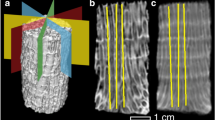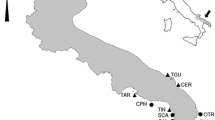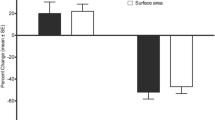Abstract
Data from two studies of growth and bioerosion of the Australian spongeCliona orientalis were used to investigate methods to quantify endolithic clionid sponge tissue in experimental blocks made from 8 massive Great Barrier Reef coral species and fromTridacna squamosa shells. Three radiography techniques were tried: conventional X-radiography, phase-contrast radiography, and computer tomography. Radiographs were compared to images of sponge tissue manually traced onto transparent sheets: endolithic sponge tissue in 1 cm thick blocks was made visible by fixing the blocks in front of strong light for tracing. None of the three radiography techniques were found to be satisfactory to estimate the extent of endolithic clionid tissue, unless the substrate was very dense and its structure comparatively homogeneous. Otherwise, delicate sponge tissue strands were often obscured by substrate structures. This was especially the case around the margins of the sponge colony, which were not clearly resolvable. Additionally, at all radiography settings tried, sponge tissue had very little attenuation so that it could not be distinguished from empty pores in coral skeleton. Radiography was thus found to be largely unsuitable for studying endolithic tissue of Clionidae excavating small pores. Computer tomography may have considerable significance in qualitative studies, however, as this technique lowers ambiguity by permitting several observations with smaller slice thickness. Manual tracing of endolithic tissue worked surprisingly well and provided data of about 90% accuracy. Tracing is more work-intensive than radiography, but low in cost and does not require specific technology. Given a material thickness of 1 cm or less, it is non-intrusive, i.e. studied material will not be lost. Areas of superficial and endolithic sponge tissue were highly significantly proportional to each other. Hence, at least for C.orientalis, the areas of superficial tissue can be used to estimate endolithic extent without damaging the substrate. Calculation models are given. It is likely that such a correlation is a general phenomenon for clionid sponges. Use in the field is restricted by problems with species identification.
Similar content being viewed by others
References
Bak, R. P. M. (1976): The growth of coral colonies and the importance of crustose coralline algae and burrowing sponges in relation with carbonate accumulation. — Netherl. J. Sea Res.,10 (3): 285–337.
Becker, L. C. &Reaka-Kudla, M. L. (1997): The use of tomography in assessing bioerosion in corals. — Proc. 8th Internat. Coral Reef Symp. Panama,2: 1819–1823.
Bergman, K. M. (1983): The distribution and ecological significance of the boring spongeCliona viridis on the Great Barrier Reef, Australia. — Unpublished MSc Thesis McMaster University Hamilton: 69 pp.
Bosscher, H. (1993): Computerized tomography and skeletal density of coral skeletons. — Coral Reefs,12: 97–103.
Brock, R. E. &Brock, J. H. (1977): A method for quantitatively assessing the infaunal community in coral rock. — Limnol. Oceanogr.,2: 948–951.
Bromley, R. G. (1970): Borings as trace fossils andEntobia cretacea Portlock, as an example. — In: Crimes, T. P. & Harper, J. C. [Eds.]: Trace Fossils. — Geol. J. Spec. Iss.,3: 49–90.
Chazottes, V. &Le Campion-Alsumard, T. &Peyrot-Clausade, M. (1995): Bioerosion rates on coral reefs: interactions between macroborers, microborers and grazers (Moorea, French Polynesia). — Palaeogeogr. Palaeoclimatol. Palaeoecol.,113 (2–4): 189–198.
Edinger, E. N. &Risk, M. J. (1997): Sponge borehole size as a relative measure of bioerosion and palaeoproductivity. — Lethaia,29: 275–286.
Emmermann, P. (1994): Untersuchung rezenter Bohrspuren endolithischer Makrobohrer in Riffgesteinen mit Hilfe der Computertomographie. Part 2: Laborarbeit. — Diploma Thesis Univ. Kiel:77 pp.
Evans, J. W. (1969): Borers of the shell of the sea scallop,Placo-pecten magellanicus. — Amer. Zoologist,9: 775–782.
Goreau, T. F. &Hartman, W. D. (1963): Boring sponges as controlling factors in the formation and maintenance of coral reefs. — In: Soggnaes, R. F. [Ed.]: Mechanisms of Hard Tissue Destruction. — Amer. Assoc. Adv. Sci. Publ.,75: 25–54.
Hassan, M. (1997): Modification of carbonate substrata by bioerosion and bioaccretion on coral reefs of the Red Sea. — PhD Thesis Univ. Kiel: 127 pp.
Highsmith, R. C. &Lueptow, R. L. &Schonberg, S. C. (1983): Growth and bioerosion of three massive corals on the Belize barrier reef. — Mar. Ecol. Progr. Ser.,13 (2–3): 261–271.
Holmes, K. E. (1997): Eutrophication and its effect onbioeroding sponge communities. — Proc. 8th Internat. Coral Reef Symp. Panama,2: 1411–1416.
Hudson, J. H. (1977): Long-term bioerosion rates on a Florida reef: a new method. — Proc. 3rd Internat. Coral Reef Symp. Miami FL,2: 491–497.
Hutchings, P. A. &Bamber, L. (1985): Variability of bioerosion rates at Lizard Island, Great Barrier Reef: preliminary attempts to explain these rates and their significance. — Proc. 5th Internat. Coral Reef Congr. Tahiti,2: 333–338.
Hutchings, P. A. &Kiene, W. E. &Cunningham, R. B. &Donelly, C. (1992): Spatial and temporal patterns of non-colonial organisms (Polychaetes, sipunculans and bivalve molluscs) inPorites at Lizard Island, Great Barrier Reef. — Coral Reefs,11: 23–31.
Hutchings, P. A. &Peyrot-Clausade, M. (1988): Macro-infaunal boring communities ofPorites. A biogeographical comparison. — Proc. 6th Internat. Coral Reef Symp. Townsville, Australia,3: 263–267.
Hutchings, P. A. &Weate, P. B. (1978): Comments on the technique of acid dissolution of coral rock to extract endo-cryptolithic fauna. — Austral. Zool.,19: 315–320.
Kiene, W. E. (1985): Biological destruction of experimental coral substrates at Lizard Island (Great Barrier Reef, Australia). — Proc. 5th Internat. Coral Reef Congr. Tahiti,5: 339–344.
Kiene, W. E. &Hutchings, P. A. (1992): Long-term bioerosion of experimental coral substrates from Lizard Island, Great Barrier Reef. — Proc. 7th Int. Coral Reef Symp. Guam,1: 397–403.
Kiene, W. E. &Hutchings, P. A. (1994): Bioerosion experiments at Lizard Island, Great Barrier Reef. — Coral Reefs,13: 91–98.
Lozän, J. L. (1992): Angewandte Statistik für Naturwissenschaftler. — 237 pp.; Berlin, Hamburg (Parey).
MacGeachy, J. K. &Stearn, C. W. (1976): Boring by macro-organisms in the coralMontastrea annularis on Barbados reefs. — Internat. Revue ges. Hydrobiol.,61 (6): 715–745.
MacIntyre, I. G. (1983): Preburial and shallow subsurface alteration of modern scleractinian corals. — Paleontogr. Amer.,54: 229–244.
Moore, C. H. &Shedd, W. W. (1977): Effective rates of sponge bioerosion as a function of carbonate production. — Proc. 3rd Internat. Coral Reef Symp. Miami FL,2: 499–505.
Peyrot-Clausade, M. &Brunel, J.-F. (1990): Distribution patterns of macroboring organisms on Tuléar reef flats (SW Madagascar). — Mar. Ecol. Progr. Ser.,61: 133–144.
Peyrot-Clausade, M. &Hutchings, P. A. &Richard, G. (1992): Temporal variations of macroborers in massivePorites lobata on Moorea, French Polynesia. — Coral Reefs,11: 161–166.
Reaka-Kudla, M. L. &Feingold, J. S. &Glynn, W. (1996): Experimental studies of rapid bioerosion of coral reefs in the Galápagos Islands. — Coral Reefs,15: 101–107.
Risk, M. J. &Sammarco, P. W. &Edinger, E. N. (1995): Bioerosion inAcropora across the continental shelf of the Great Barrier Reef. — Coral Reefs,14: 79–86.
Rose, C. S. &Risk, M. J. (1985): Increase inCliona delitrix infestation ofMontastrea cavernosa heads on an organically polluted portion of the Grand Cayman fringing reef. — Pubbl. Staz. zool. Napoli I: Mar. Ecol,6 (4): 345–363.
Rosell, D. (1994): Morphological and ecological relationships of two clionid sponges. — Ophelia,40 (1): 37–50.
Rützler, K. (1971): Bredin-Archbold-Smithsonian biological survey of Dominica: burrowing sponges, genusSiphonodictyon Bergquist, from the Caribbean. — Smithsonian Contrib. Zool.,77: 1–37.
Sammarco, P. W. &Risk, M. J. (1990): Large-scale patterns in internal bioerosion ofPorites: cross continental shelf trends on the Great Barrier Reef. — Mar. Ecol. Progr. Ser.,59: 145–156.
Schönberg, C. H. L. (2000): Bioeroding sponges common to the Central Australian Great Barrier Reef: descriptions of three new species, two new records, and additions to two previously described species. — Senckenbergiana mark.,30 (3/6): 161–221.
Schönberg, C. H. L. (in press): Small-scale distribution of Great Barrier Reef bioeroding sponges in shallow water. — Ophelia.
Schönberg, C. H. L. (in review): Clionid sponge growth and bioerosion in different kinds of substrates — an experimental approach. — J. exp. mar. Biol. Ecol.
Schönberg, C. H. L. (in prep.): Nutrients and water movement as factors controlling growth and bioerosion of a Great Barrier Reef clionid sponge.
Scoffin, T. P. &Stearn, C. W. &Boucher, D. &Frydl, P. &Hawkins, C. M. &Hunter, I. G. &MacGeachy, J. K. (1980): Calcium carbonate budget of a fringing reef on the west coast of Barbados. — Bull. mar. Sci.,30 (2): 475–508.
Stearn, C. W. &Scoffin, T. P. (1977): Carbonate budget of a fringing reef, Barbados. — Proc. 3rd Internat. Coral Reef Symp. Miami FL,2: 471–476.
Warme, J. E. &Marshall, N. F. (1969): Marine borers in calcareous terrigenous rocks on the Pacific Coast. — Amer. Zoologist,9: 765–774.
Wilkins, S. W. &Gureyev, T. E. &Gao, D. &Pogany, A. &Stevenson, A. W. (1996): Phase-contrast imaging using polychromatic hard X-rays. — Nature,384: 335–338.
Author information
Authors and Affiliations
Rights and permissions
About this article
Cite this article
Schönberg, C.H.L. Estimating the extent of endolithic tissue of a great barrier reef clionid sponge. Senckenbergiana maritima 31, 29–39 (2001). https://doi.org/10.1007/BF03042834
Received:
Revised:
Accepted:
Issue Date:
DOI: https://doi.org/10.1007/BF03042834




